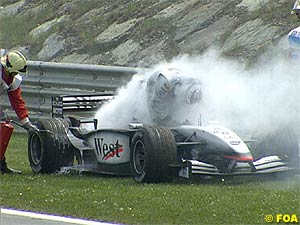
Atlas F1 Senior Writer
At least four drivers retired from Sunday's Austrian Grand Prix after spectacular blowups of their respective engines, most notably the Mercedes of Kimi Raikkonen and the Hondas of the two BAR drivers. Karl Ludvigsen believes that means they are finally moving forward this year
These days, of course, the driver's job should be replaced by the telemetry from the car. Engineers receive a constant stream of data on the key engine parameters. If any diverge from nominal they get an instant warning. The forces in these high-revving engines are so extreme, however, that a failure can be instantaneous. That seems to have been the case with most of the flaming failures at the A-1 Ring, where engines are running at peak power for 60 percent of the lap. Clearly none of these hapless drivers was given much of a warning.
When I saw Kimi's Mercedes eruption I thought, "Well, that's the last straw. Mercedes will be irate. Ilmor's in for it." On second thought, however, I revised that assessment. Although still not up to the standards of either McLaren or Mercedes-Benz, the silver cars were performing fractionally better last weekend. In response to massive pressure from both Stuttgart and Woking, the Ilmor men at Brixworth are cranking up their efforts to overcome their power deficit to leaders Ferrari and BMW. Frankly, a failure of a more powerful engine is vastly preferable to pootling around without the power to mix it with the opposition.
The same applies to Honda. The colorful explosions of its engines are an indication of the effort that Honda is making to step up its game. The points-scoring finish of Giancarlo Fisichella's Jordan shows that a result is beginning to be obtained. For the first time in ages we saw the Jacques Villeneuve of old, carving through the field from 17th to a short-lived but gratifying third place. Honda power had a lot to do with that. We hear talk of a "big push for Canada" from both Honda-powered camps, so we are now getting the impression that Honda is doing something about the sharp and unaccustomed challenge to its role as Japan's Grand Prix champion from sleepy and agricultural Toyota.
Even Cosworth seems to be getting its act together. Those Arrows didn't qualify 11th and 12th without some serious poke behind them. Again, a failure is excusable at this stage of the season if it means that the boys from Northampton are at last living up to the tradition of Cosworth, which is the building of winning racing engines. As usual, of course, the Arrows performance only served to project in high relief the appalling Jaguar situation.
I see that Richard Parry-Jones has said that Ford will back Jaguar without reservation to 2004 and beyond. "There's no exit strategy," he said. Knowing Ford as I do, I can say that this was and is a cynical statement. Ford was also wholly committed to building a new car at its Dagenham factory, right up to the day when it said that it wouldn't do so after all and that in fact it would stop making cars there. A promise from Ford is meaningless. Jaguar could be on the chopping block tomorrow.
Nevertheless the Jaguar situation is illustrative of one aspect of the debate about Formula One financing that's so much in the news at the moment. That aspect is that money alone does not a successful Grand Prix effort make. Ferrari proved that for many years. Beatrice proved it. Lotus proved it from time to time. Renault proved it in the turbo era. Money is useful, but so are continuity, ingenuity and transparency - attributes that are in short supply at Jaguar. Let's see them factor that sort of thinking into the talks about the financial future of Formula One.
I can't recall a recent race in which we had so many spectacular engine blowups as we did at Austria's A-1 Ring. Kimi Raikkonen's mushroom cloud alone was worth the price of admission. Panis's Honda went with a bang, as did Alex Yoong's Asiatech. Jacques Villeneuve's last-lap explosion completed the suite for BAR-Honda. These were epic grenadings of some very expensive racing engines.
 Seeing these sensational blowups reminded me of a remark by the late Paul Morgan of Ilmor. Talking about their development of the amazing pushrod V8 engine that won Indy for Mercedes-Benz in 1994, he said, "Looking at the engine, sometimes we just ended up with a bag of shrapnel and we had to figure out what broke first." This is the fine art of engine development. Trying to figure out what did break first - and why - is never easy. That's why those drivers who have a sixth sense for an engine that's about to blow are highly valued. They may be able to save an engine that's on the point of destruction so that the engineers have something to look at.
Seeing these sensational blowups reminded me of a remark by the late Paul Morgan of Ilmor. Talking about their development of the amazing pushrod V8 engine that won Indy for Mercedes-Benz in 1994, he said, "Looking at the engine, sometimes we just ended up with a bag of shrapnel and we had to figure out what broke first." This is the fine art of engine development. Trying to figure out what did break first - and why - is never easy. That's why those drivers who have a sixth sense for an engine that's about to blow are highly valued. They may be able to save an engine that's on the point of destruction so that the engineers have something to look at.
Please Contact Us for permission to republish this or any other material from Atlas F1.